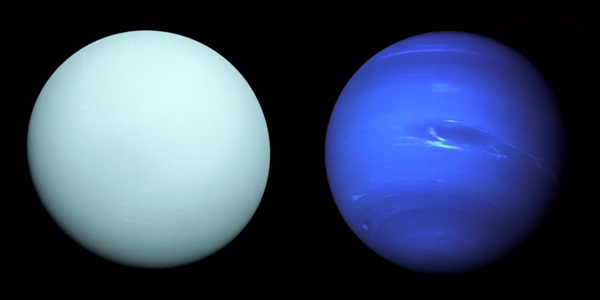Key Takeaways:
The work, published August 21 in Nature Astronomy, combined a high-powered optical laser with the X-ray free-electron laser at SLAC National Accelerator Laboratory, the Linac Coherent Light Source (LCLS). The LCLS creates X-ray pulses that last a million-billionths of a second, allowing for ultrafast high-precision monitoring of processes that occur all the way down to the scale of atoms. As a result, the researchers were able to watch tiny diamonds form as shock waves passed through plastic, offering a peek at processes that take place in planetary atmospheres on a much grander scale.
The experiment focused on inducing shock waves in a plastic material called polystyrene, which contains hydrogen and carbon — two elements found in abundance inside Uranus and Neptune. According to theory, methane (four hydrogen atoms and one carbon atom) inside the planets’ atmospheres forms hydrocarbon chains that in turn form diamonds in response to the right temperature and pressure. This occurs more than 5,000 miles (8,000 kilometers) beneath the planets’ surface. There, the diamonds precipitate out and sink deeper into the atmosphere, a “diamond rain.”
Though this has been assumed to be the case for decades, the exact process has never been observed in experiments on Earth before now. Some previous experiments failed because the pressures and temperatures inside the atmospheres of these planets cannot be created in the lab for long, and without the ability to record data at the speed afforded by the LCLS, any transitions were missed. Other experiments produced graphite or diamond, but were conducted at lower pressures or required the introduction of additional materials.
Using an optical laser, the researchers induced one, then a second shockwave in a polystyrene sample at the temperatures and pressures found within Uranus and Neptune. As they probed the material with 50-femtosecond X-ray pulses (a femtosecond is a quadrillionth of a second), they watched the carbon atoms in the plastic become part of tiny diamonds (called nanodiamonds) where the shockwaves overlapped, creating areas of higher pressure.
“For this experiment, we had LCLS, the brightest X-ray source in the world,” said Siegfried Glenzer, professor of photon science at SLAC and a coauthor on the paper, in a press release. “You need these intense, fast pulses of X-rays to unambiguously see the structure of these diamonds, because they are only formed in the laboratory for such a very short time.”
Dominik Kraus of Helmholtz Zentrum Dresden-Rossendorf and lead author on the paper, added, “When I saw the results of this latest experiment, it was one of the best moments of my scientific career.”
This work will benefit not only planetary scientists seeking to understand the conditions inside our own local ice giants, but those studying extrasolar planets as well. Learning more about how elements combine and precipitate out of atmospheric layers allows researchers to create better models for a deeper understanding of these planets, including not only their weather, but their sources of energy as well. Diamond rain could create friction as the diamonds sink deeper within the atmosphere, generating heat and affecting atmospheric circulation and other conditions.
“We can’t go inside the planets and look at them,” Kraus said, “so these laboratory experiments complement satellite and telescope observations.”
The nanodiamonds resulting from this experiment could have other applications closer to home as well, such as use in the medical and technology industries. While such nanodiamonds can be produced in explosions, manufacturing them with lasers could be a cleaner alternative.










